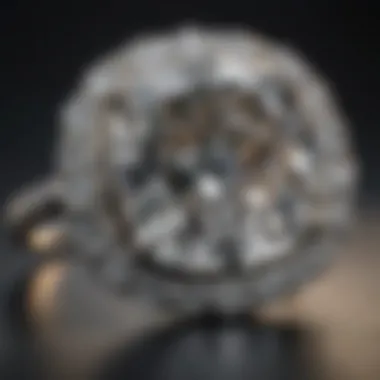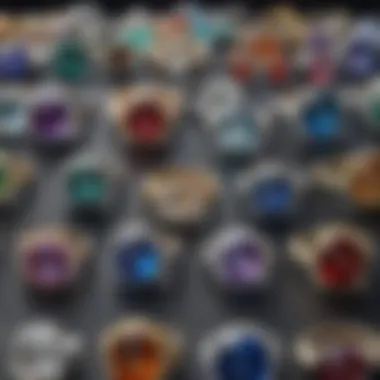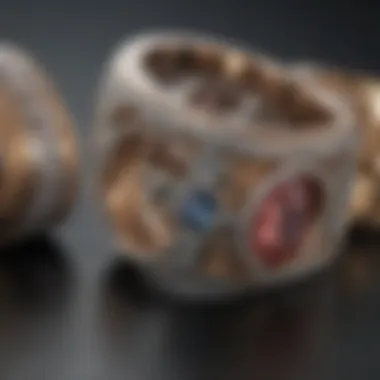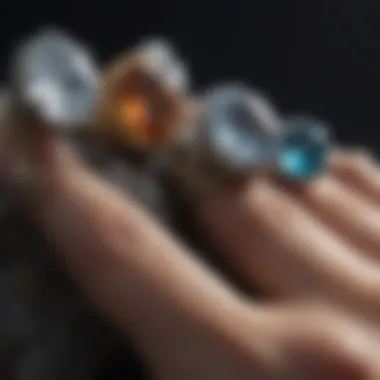Choosing the Best Ring Cuts for Broader Fingers


Intro
Selecting the right ring cut for wider fingers is a careful balancing act between aesthetics and functionality. For those with broader digits, the choice of cut can significantly amplify the visual effect of the ring while providing comfort. It’s not just about style; it’s about making the ring complement the hand in a way that feels right.
With a plethora of cuts available, from the classic round to the modern cushion, understanding what works best for wider fingers requires an insight into both the gemstone and the finger shape. This article will guide you through various aspects, touching on the necessary details that influence your decision. We’ll emphasize key points such as sizing, width considerations, and design elements, ultimately helping you navigate through the options to find something that fits beautifully in both style and comfort.
Understanding Ring Cuts
Choosing the right ring cut is more than just a matter of aesthetics; it significantly influences how a ring is perceived on wider fingers. Wider fingers can create specific visual challenges, and the cut of a stone plays a pivotal role in enhancing the overall look and feel of a ring.
Each ring cut brings its own character and charm, which can either emphasize or mitigate the natural characteristics of wider fingers. When a ring is well-cut, it not only reflects light beautifully but also offers a comfortable fit, making it essential to delve into the world of ring cuts in the quest for the perfect piece.
The way a diamond or gemstone is cut affects its brilliance and how it complements the wearer's hand shape. For those with wider fingers, certain cuts can elongate the appearance of the fingers, creating a more balanced look. Therefore, understanding the various ring cuts allows individuals to make educated choices that serve both aesthetic and functional purposes.
Historical Context of Ring Cuts
Historically, the art of cutting gemstones has evolved remarkably. In ancient times, rings often featured uncut stones, which showcased their natural beauty. It wasn't until the Middle Ages that jewelers began experimenting with cuts to maximize the sparkle of a gem. For example, the rose cut, developed in the 16th century, highlighted a stone's soft glow. On the contrary, modern diamond cuts like the brilliant cut emerged in the late 19th century, emphasizing a stone's scintillation.
Rings were symbols of status and commitment, as seen with wedding bands and signet rings, which often featured specific designs reflecting societal values and craftsmanship of that time. These historical aspects highlight the deeper cultural implications of ring cuts, especially when considering the needs and preferences of wider fingers today. Understanding these historical contexts better equips individuals to appreciate the significance of various cuts and their role in contemporary jewelry design.
Importance of Ring Cut in Design
The significance of the ring cut cannot be overstated. A well-selected cut can flatter wider fingers, making them appear more elongated or balanced. Furthermore, the cut affects not just how light interacts with the stone, but also how it is set within the ring. For example, cuts with softer edges, like the cushion cut, can soften the look of wider fingers when set in certain styles, contrasting the sharper styles of the princess cut which might emphasize thickness.
Moreover, the cut influences other aspects such as:
- Setting choices: Some cuts pair better with certain settings. A round cut stone, for instance, offers versatility, fitting well with a variety of settings.
- Style compatibility: Depending on the cut, certain band styles may complement the overall design more effectively.
- Comfort level: As mentioned earlier, width and fit can be greatly affected by the chosen cut, especially when it involves maximizing comfort for wider fingers.
Understanding the characteristics of different ring cuts can make all the difference in creating a beautiful and comfortable piece of jewelry for those with wider fingers.
Characteristics of Fat Fingers
Understanding the characteristics of wider fingers is crucial when choosing the ideal ring cut, as it lays the foundation for a perfect fit and aesthetic harmony. This section dives into the defining qualities of what many refer to as 'fat fingers' and the common concerns that come with them. By exploring these aspects, jewelers and wearers alike can make informed decisions that combine comfort and style.
Defining 'Fat Fingers'
The term 'fat fingers' isn’t simply a derogatory label; instead, it describes hands that exhibit a fuller and broader appearance. These fingers might be the result of factors like genetics, lifestyle, or age. While it's important not to stigmatize these features, recognizing their implications in ring selection will ensure a more tailored experience.
When discussing fat fingers, it's not just about the width; it’s about proportion. Wider fingers often have larger knuckles, which can make it tricky to find rings that both fit snugly and look aesthetically pleasing. A proper definition includes elements of girth and their overall impact on ring design.
For example, consider this analogy: just like a well-tailored suit enhances a person's physique, the right ring cut enhances the natural beauty of wider fingers. Understanding this can transform the perception of ring selection into an empowering experience.
Common Concerns for Wider Fingers
The journey to finding the perfect ring cut for wider fingers comes with its own set of challenges and considerations. Here are some common concerns faced:
- Fit Issues: A ring that’s too small can pinch, causing discomfort, while one that’s too large risks slipping off. This is particularly true for wider fingers with more prominent knuckles.
- Visual Balance: Rings that are not designed for wider fingers can appear disproportionate, making the fingers look bulkier. Individuals often want a cut that creates balance rather than detracts from their hand’s aesthetics.
- Design Selection: Certain styles may simply not look good on wider fingers. For example, intricate designs can get lost or appear cluttered against fuller digits. It’s essential to select cuts that accentuate rather than overwhelm.
- Material and Weight: Heavier rings may not sit well on wider fingers, leading to a feeling of bulkiness. Consequently, opting for lighter materials can promote a better wearing experience.
"A ring should make a statement, not just fit a finger. Understanding the unique traits of wider fingers evoloves the selection process from mere choice to a thoughtful art."


Overall, recognizing these characteristics allow individuals to navigate the nuances of wider fingers and select ring cuts that enhance their style while ensuring comfort. With a thoughtful approach, wearing a ring can transform from a simple accessory into a powerful form of self-expression.
Best Ring Cuts for Comfort and Style
Selecting the right ring cut is crucial for both aesthetics and comfort, especially for those with wider fingers. Beyond mere aesthetics, the right cut can enhance the structural integrity of the ring and its wearability. The interplay between the ring’s design and the finger's proportions dictates much of how a ring fits and feels. For individuals with more substantial fingers, finding a cut that suits their unique shape is essential. A well-chosen cut can draw attention away from the finger's width, creating a more balanced and harmonious look.
The Round Cut
Features of Round Cut
The round cut is perhaps the most recognized diamond shape, designed with 58 facets. These facets are precisely arranged to maximize brilliance. Its classic and symmetrical design helps it adapt well to various styles, making it a versatile choice. The round cut's popularity springs from its ability to offer optimal light reflection, making any stone appear more radiant.
Visual Appeal for Wider Fingers
When considering wider fingers, the round cut stands out for its ability to create an illusion of length. The rounded edges gently soften the finger's appearance, and the symmetry catches the eye without overwhelming the hand's natural proportions. This cut's visual harmony can effectively distract from width while emphasizing beauty.
Recommended Settings
For a round cut, the traditional solitaire setting is a crowd-pleaser, but other styles like halo settings can be equally alluring. A halo setting, for instance, frames the center stone with smaller stones, increasing the ring's visual surface area. Such settings can enhance comfort by creating a less pronounced focal point on the finger, helping bridge the gap between width and elegance.
The Princess Cut
Defining Characteristics
The princess cut is a modern classic with its sharp corners and brilliant facets. Known for its squarish silhouette, it interlaces sophistication with contemporary flair. Its geometry allows light to reflect deeply, showcasing stones’ internal sparkle. For those with wider fingers, its angular shape can counterbalance larger proportions effectively.
Best for Comfort
In terms of comfort, the princess cut can be advantageous. The corners, being less pronounced than those of other cuts, allow for more flexibility in design. This often leads to better fitting rings that won’t dig into the skin, making it a smart choice for individuals who prioritize comfort without sacrificing style.
Pairing with Vintage Styles
This cut also pairs beautifully with vintage-inspired band styles such as filigree, which harkens back to intricate designs of the past. The contrast of contemporary princess cuts with vintage details creates a unique juxtaposition, providing a statement piece that is both modern and timeless. It caters to those who want a ring that doesn’t just fit their fingers, but also fits their personal style.
The Cushion Cut
Soft Edges and Elegance
Cushion cuts, with their rounded corners and larger facets, radiate an old-world charm while still being fashionable today. The soft edges create a more soothing look, making it a suitable choice for those concerned with the appearance of wider fingers. Its graceful design manages to be both romantic and chic, contributing to its widespread appeal.
Feminine Aesthetic
The cushion cut is particularly favored for its ability to evoke femininity. It exudes a delicate vibe that can soften the overall look of a hand, making wider fingers appear more refined. This makes it ideal for anyone seeking a touch of elegance in their ring, without compromising on style.
Fitting Recommendations
When selecting a cushion cut, consider a setting that holds the stone securely while still allowing light to pass through the facets. Open prong settings are favorable as they enhance the ring’s overall brilliance. Ring width matters too; a slightly wider band can balance the cushion’s larger look, ensuring both comfort and style resonate well together.
The Emerald Cut
Distinctive Clarity and Lines


The emerald cut, with its unique rectangular shape and step facets, provides a different spin on brilliance. Unlike traditional cuts that focus on light play, this cut emphasizes clarity and the stone's internal characteristics. It shines through elegance and sophistication, making it an excellent choice for wider fingers, as its elongated form can help create a lengthening effect.
Suitability for Wider Fingers
Its angular shape can enhance the look of substantial fingers, steering the eye along the length of the ring rather than its width. This quality makes the emerald cut particularly popular among those looking for a distinctive style while ensuring that their finger’s width does not detract from the ring’s beauty.
Matching Bands
When pairing bands with an emerald cut, consider sleek, straight bands that don’t overpower the simplicity of the cut. Such bands help maintain an elegant profile while offering ample support. Wider bands can balance proportions beautifully, therefore enhancing the overall aesthetic appeal.
The Asscher Cut
Timeless Beauty
Much like the emerald cut, the Asscher cut is also known for its step facets and geometric elegance. Its square shape offers a vintage feel while maintaining a contemporary touch. This timeless cut often appeals to those who appreciate artistry and craftsmanship in their jewelry.
Creating Illusion of Length
For those with wider fingers, the Asscher cut can similarly elongate appearance due to its symmetrical design. The way it captures light adds an extra dimension, making rings more captivating. By reflecting light beautifully, this cut draws attention away from the finger's width.
Setting Variations
Asscher cuts pair well with various settings, including modern and vintage styles. Consider settings that elevate the stone, such as four-prong or bezel settings. These enhance visibility while allowing for comfort. The choice of a structured band can further optimize the cut’s stunning features.
The Oval Cut
Elongation Benefits
The oval cut offers an excellent solution for wider fingers by naturally elongating the look of the hand. Made with a similar facet arrangement as the round cut, this shape can catch light, generating a stunning halo of brilliance. This quality adds desirability as it aesthetically alters finger proportions positively.
Balancing Proportions
The oval cut also excels at balancing proportions. It’s wide enough to fill space but narrow enough to afford elegance. This balance can flatter wider fingers, providing an overall harmonious look. In effect, it allows wearers the freedom to indulge in bold designs without worrying about visual imbalance.
Popular Ring Styles
When considering the oval cut, you’ll find it suits a variety of styles, from solitaires to pavé settings. The versatility of this cut also lends itself well to stacking rings, which can be a fashionable fillion. Thus, wearers gain both style and comfort, ensuring their rings align with personal tastes and finger versatility.
In the world of jewelry, it’s vital to find a ring cut that doesn’t just fit but also resonates with personal style. Choosing wisely can make a remarkable difference, elevating both comfort and elegance in our everyday wear.
Crafting the perfect ring isn’t merely about picking a shiny rock; it’s about creating a harmony between personal flair and practical wear.
Practical Considerations in Ring Selection
When it comes to selecting the perfect ring for wider fingers, practical considerations play a pivotal role. It's more than just a matter of aesthetics; the right choices can significantly impact comfort, durability, and overall satisfaction with the piece. This section will elucidate these elements, focusing on accurate finger measurements, the importance of band width, and material choices.
Measuring Finger Size Accurately
Getting the finger size right can often be the difference between a ring that sits snugly and one that slips or pinches. Wider fingers present unique challenges, so it is essential to take precise measurements to ensure the right fit. Factors like temperature, time of day, and even activity level can influence finger size.


- Use a flexible measuring tape or a piece of string to wrap around the finger at the base.
- Avoid measuring when your hands are warm, as they can expand and lead to inaccurate results.
- It can be prudent to measure at different times and take the average for the best fit.
A well-fitting ring not only looks better but also feels more comfortable, allowing the wearer to showcase the jewelry without distraction.
Ring Width and Comfort
Choosing the Right Band Width
Many people overlook the significance of band width when choosing a ring. Wider bands can be beneficial for those with fuller fingers, as they distribute weight more evenly. A broader band might not only enhance comfort but can also serve to balance proportions. Choosing a band width that matches the scale of the finger is a common practice that helps in achieving harmony in appearance.
- Wider bands (around 6mm or more) can create a substantial look without overemphasizing finger size.
- Thinner bands can sometimes appear lost on wider fingers, which might lead to discomfort in some cases.
However, going too wide can feel cumbersome for some. It is essential to try on several options to find that sweet spot.
Factors Affecting Comfort
Various elements contribute to the comfort of wearing a ring, especially for wider fingers. The profile of the band, along with how it interacts with the skin, is vital. Comfort-fit rings, which are slightly rounded on the inside, allow better mobility and can feel less restrictive.
- The finish of the ring can also play a role in comfort; polished inner bands might slide on easily but can cause friction depending on the wearer's skin type.
- Additionally, lifestyle plays a part; for someone on the move often, comfort should take precedence over style.
Exploring different designs ahead of time helps in pinpointing the elements that contribute to a comfortable fit.
Materials and Durability
Selecting the appropriate materials can enhance both the look of the ring and its longevity. For wider fingers, it’s important to choose metals that not only fit the aesthetic but also hold up over time.
Metal Recommendations
When it comes to metal choices, there are a few standouts worth mentioning. Gold, platinum, and titanium can be excellent choices for wider finger rings.
- Gold offers a classic appeal, especially yellow gold which has a warm elevation to it. Higher karat gold is softer but provides beauty.
- Platinum is known for its durability and resistance to wear; it’s a great choice if you're seeking something long-lasting.
- Titanium provides a modern twist, being lightweight yet incredibly strong, perfect for those who prefer a minimalist look without sacrificing durability.
Each option has its unique characteristics, so it’s essential to weigh their pros and cons based on personal preference and lifestyle needs.
Impact on Weight and Balance
The weight and balance of a ring can greatly affect how comfortable it feels over extended wear. Particularly for wider fingers, it's crucial to consider how heavy a ring might feel due to its size.
- A ring that is too heavy can cause fatigue, especially if it's worn daily, while lighter options might feel barely there.
- Balancing weight through design, like a split shank or open styles, can help achieve a comfortable fit that doesn’t compromise on statement.
The key is to choose a ring that feels good on the finger while enhancing the wearer’s style.
In summary, practical considerations in ring selection for wider fingers involve precision in measurements, selecting the right band width, and durable materials. These factors ensure that the ring not only looks appealing but also provides a comfortable wearing experience.
Closure
Choosing the right ring cut is not just about aesthetics; it plays a crucial role in making a piece of jewelry truly special, especially for those with wider fingers. This article has explored various ring cuts, highlighting how specific shapes can enhance comfort and style. Each cut has its own characteristics and allure, and when chosen wisely, it can complement the unique qualities of broader fingers.
Summary of Key Points
- Understanding Ring Cuts: From historical significance to their role in design, the choice of ring cut influences everything from how a stone sparkles to how it feels on one's finger.
- Characteristics of Wider Fingers: Recognizing the defining traits of-wide fingers allows for a tailored selection that enhances both comfort and visual appeal.
- Best Cuts for Wider Fingers: Each cut, from the rounded silhouette of the round cut to the sophisticated lines of the emerald cut, offers distinct advantages that cater to those with broader fingers.
- Practical Considerations: Finger size, ring width, and material choice are essential elements that must coexist with the chosen cut to achieve the best fit and durability.
Final Thoughts on Choosing the Right Cut
Ultimately, selecting the ideal ring cut for wider fingers comes down to understanding individual needs and desires. Factors such as personal style and comfort preferences should guide this monumental decision. A ring is more than just a piece of jewelry; it embodies cherished memories and promises. Therefore, careful deliberation in choosing the cut, along with considering factors such as width, material, and design, can help ensure that the ring not only looks stunning but also feels perfect on the finger.
In this exploration of ring cuts, readers are encouraged to consider both the aesthetic and functional aspects of their choice. When you find the right match, that ring will not only sit beautifully upon a wider finger but will also become a beloved constant in your life—a symbol entwined with your story.







